Gas turbine vane
Brandl , et al.
U.S. patent number 10,221,709 [Application Number 14/974,831] was granted by the patent office on 2019-03-05 for gas turbine vane. This patent grant is currently assigned to ANSALDO ENERGIA SWITZERLAND AG. The grantee listed for this patent is ANSALDO ENERGIA SWITZERLAND AG. Invention is credited to Herbert Brandl, Marc Widmer.
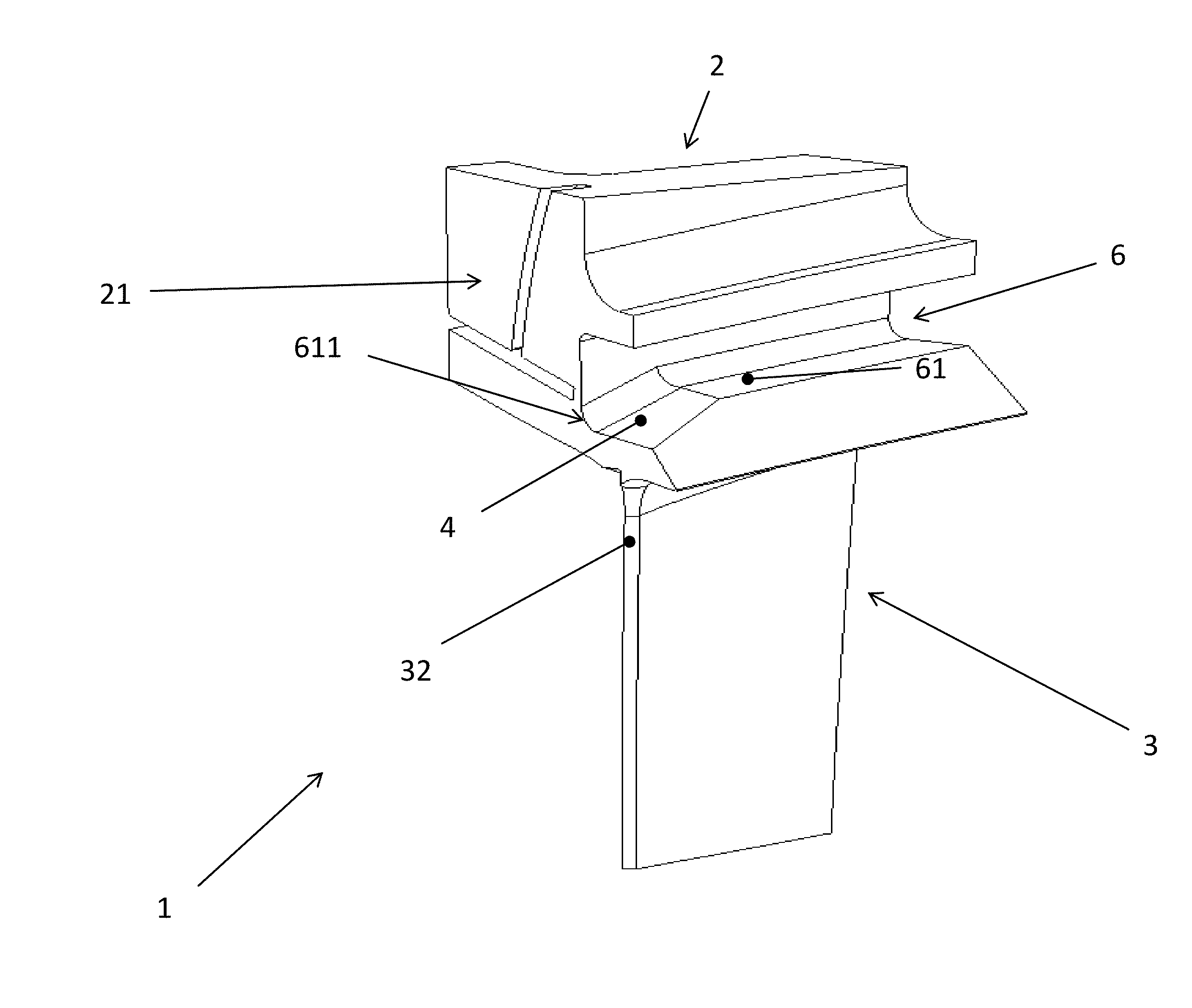
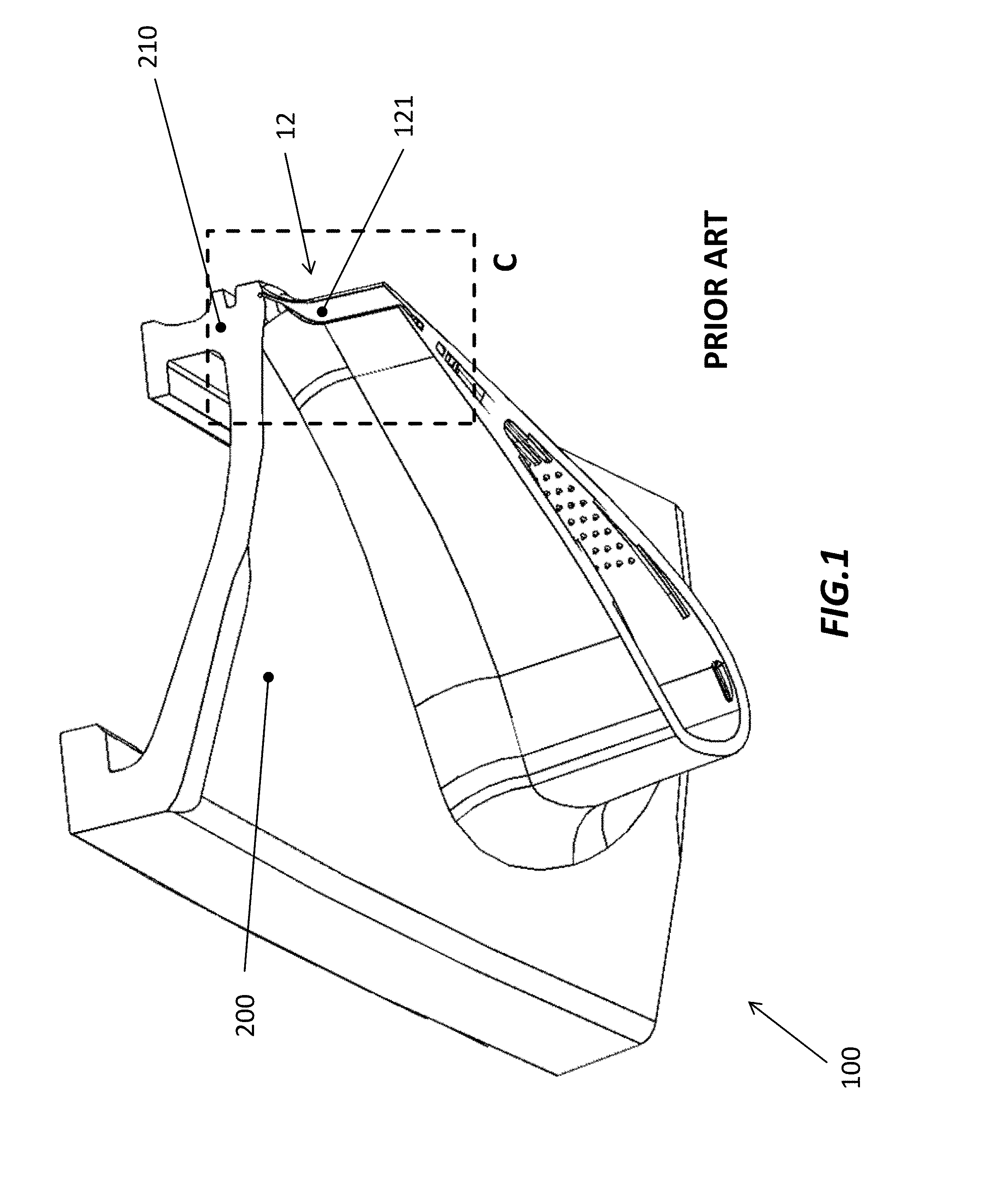


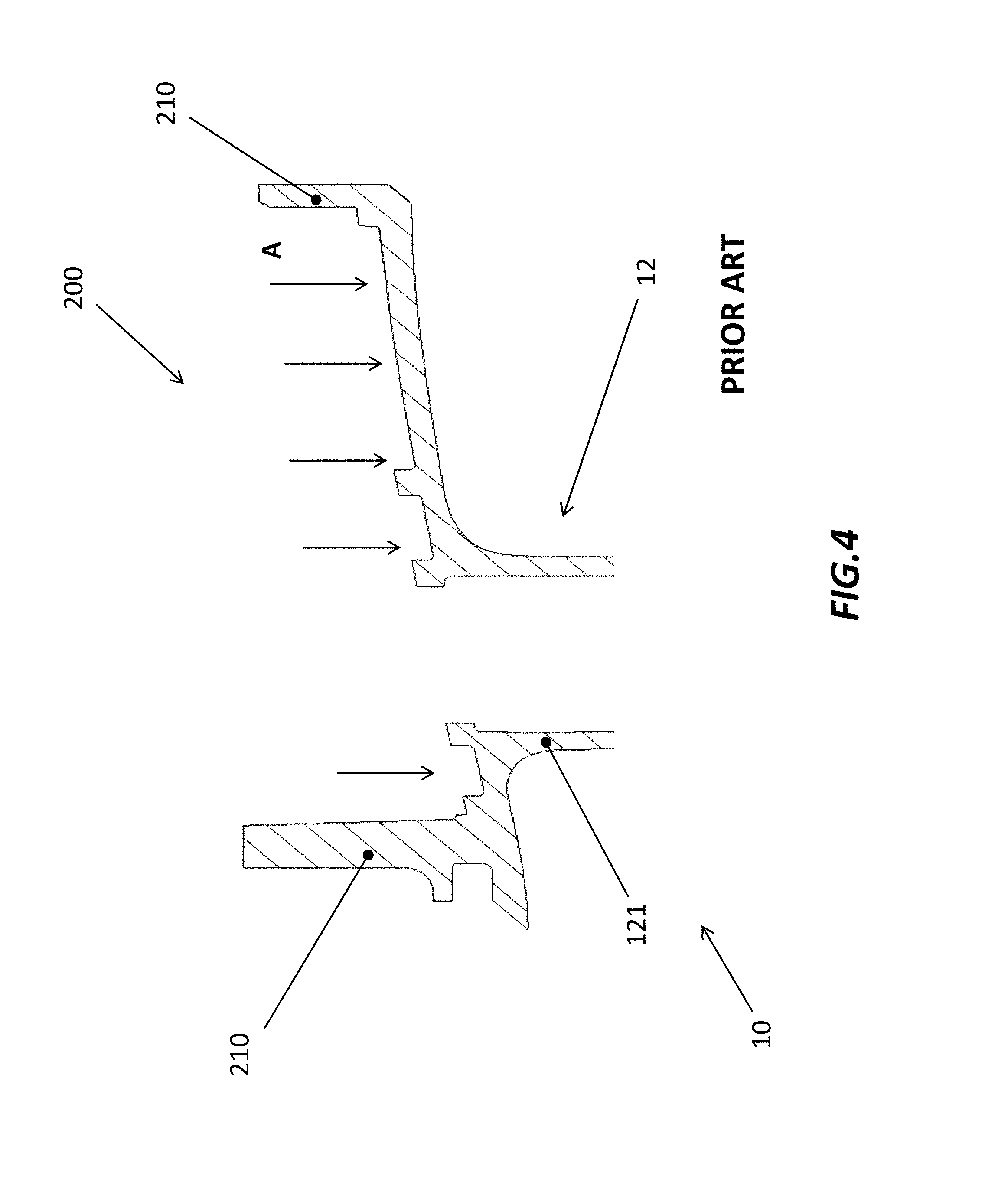


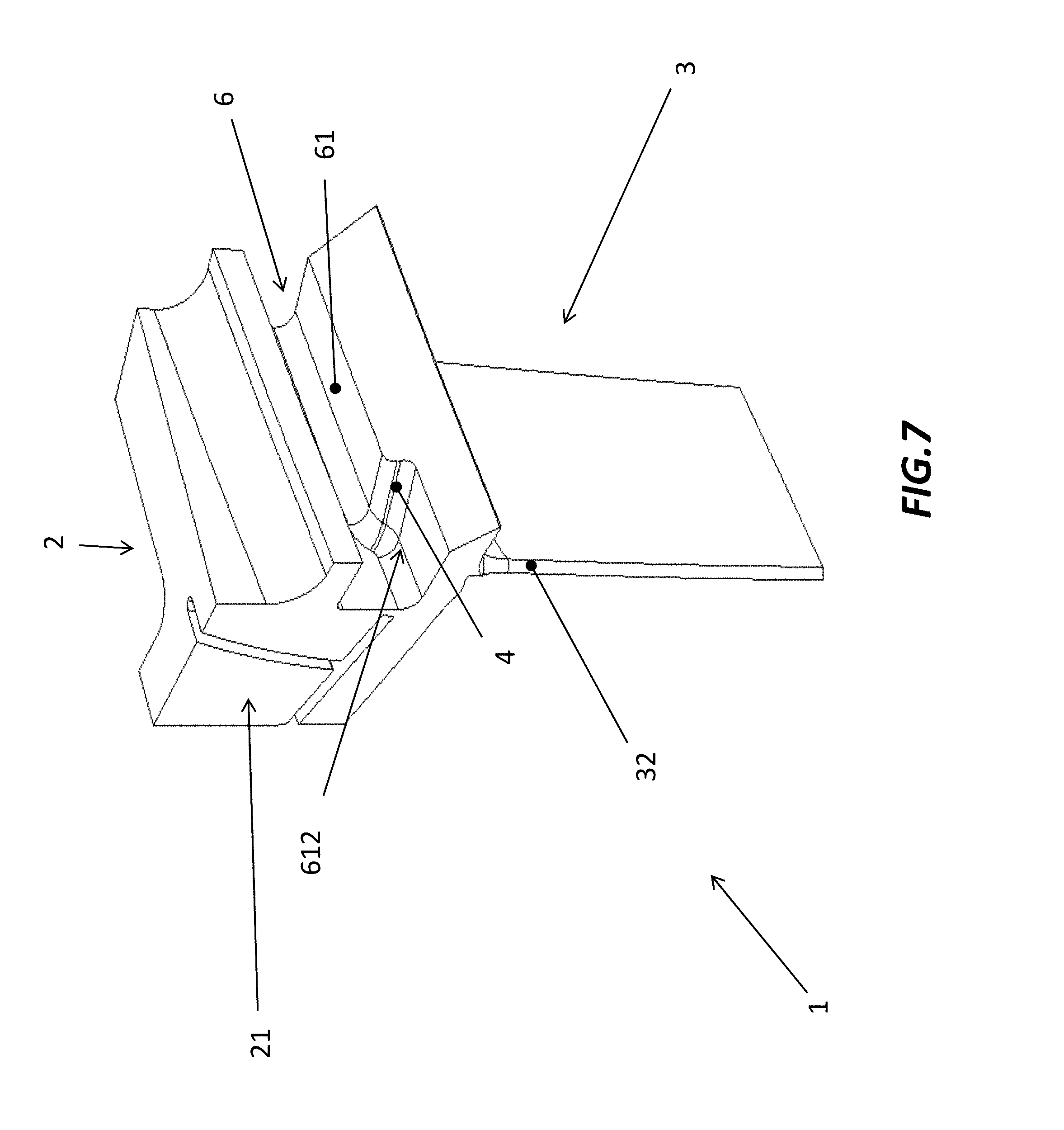
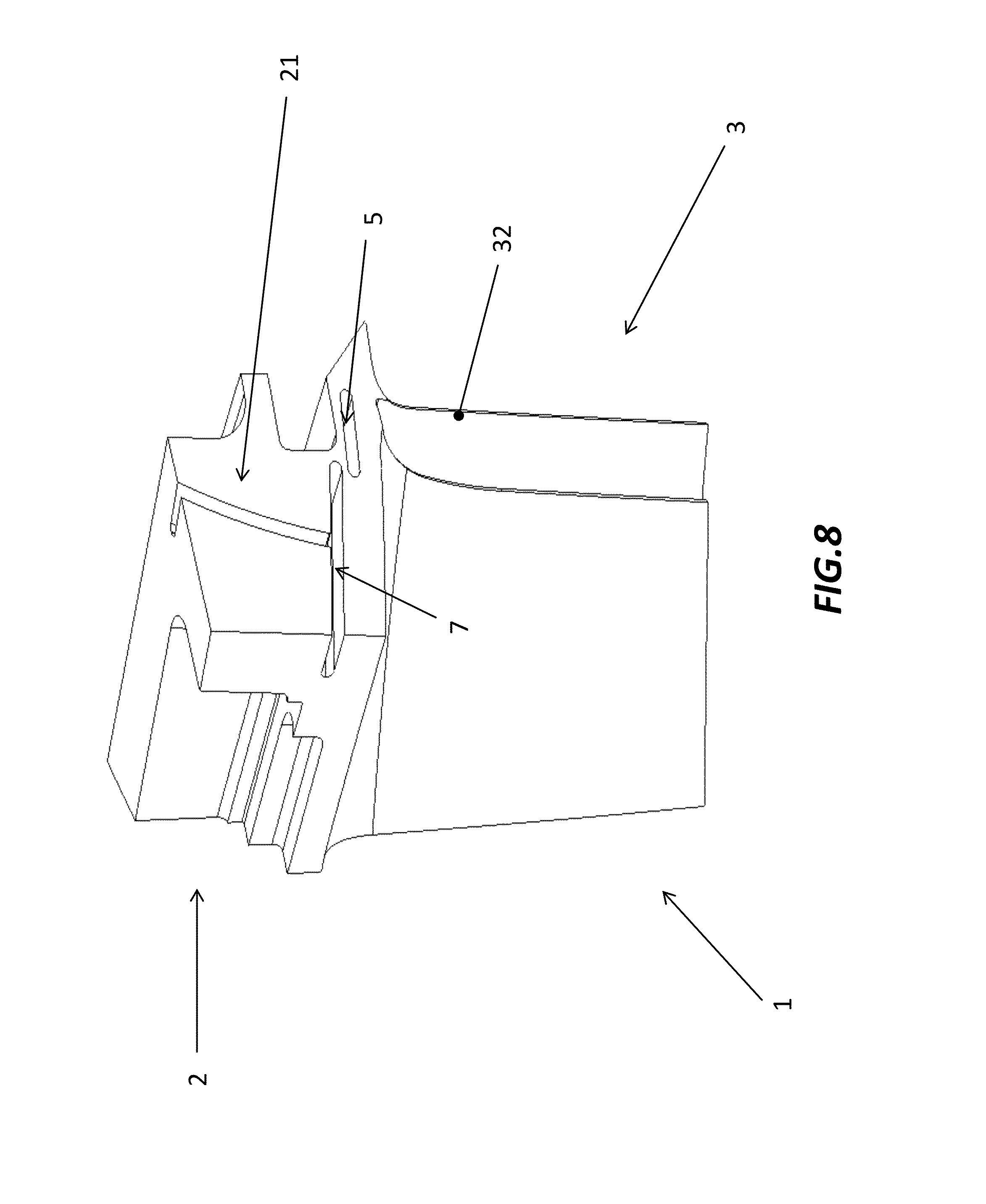
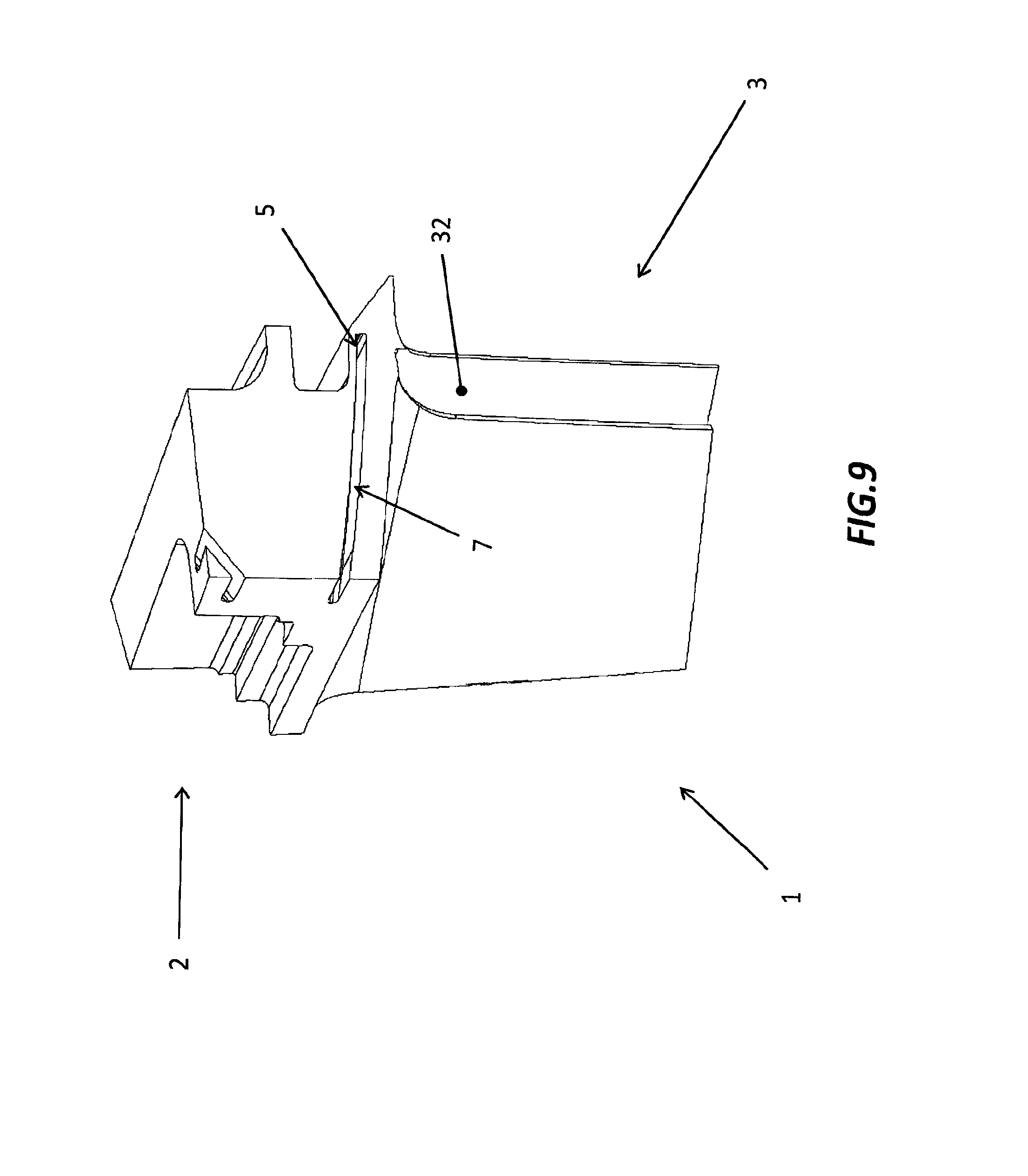
| United States Patent | 10,221,709 |
| Brandl , et al. | March 5, 2019 |
Gas turbine vane
Abstract
The present invention generally relates to a vane for a gas turbine, and more in particular it provides an innovative vane with improved flexibility leading to a reduction of stresses at the transition from the vane trailing edge to the vane platform, without interfering into the cooling scheme of such component. The present invention can increase flexibility of the vane platform by introducing on the vane platform a material cutback confined in the proximity of the trailing edge portion of the vane airfoil.
| Inventors: | Brandl; Herbert (Waldshut-Tiengen, DE), Widmer; Marc (Winterthur, CH) | ||||||||||
|---|---|---|---|---|---|---|---|---|---|---|---|
| Applicant: |
|
||||||||||
| Assignee: | ANSALDO ENERGIA SWITZERLAND AG
(Baden, CH) |
||||||||||
| Family ID: | 52146195 | ||||||||||
| Appl. No.: | 14/974,831 | ||||||||||
| Filed: | December 18, 2015 |
Prior Publication Data
| Document Identifier | Publication Date | |
|---|---|---|
| US 20160177760 A1 | Jun 23, 2016 | |
Foreign Application Priority Data
| Dec 18, 2014 [EP] | 14198730 | |||
| Current U.S. Class: | 1/1 |
| Current CPC Class: | F01D 9/041 (20130101); F01D 25/12 (20130101); F05D 2240/122 (20130101); F05D 2260/941 (20130101); F05D 2240/80 (20130101); F05D 2240/81 (20130101); F05D 2220/32 (20130101) |
| Current International Class: | F01D 9/04 (20060101); F01D 25/12 (20060101) |
| Field of Search: | ;415/193A |
References Cited [Referenced By]
U.S. Patent Documents
| 2873088 | February 1959 | Neumann |
| 3304055 | February 1967 | Britt |
| 3503696 | March 1970 | Bouiller |
| 4120607 | October 1978 | Coplin |
| 4457668 | July 1984 | Hallinger |
| 5193982 | March 1993 | Inizan |
| 5256035 | October 1993 | Norris |
| 6082970 | July 2000 | Tsukamoto |
| 6273683 | August 2001 | Zagar |
| 6419447 | July 2002 | Watanabe |
| 6761536 | July 2004 | Bash |
| 6997673 | February 2006 | Morris |
| 7419361 | September 2008 | Byam |
| 7597536 | October 2009 | Liang |
| 8047787 | November 2011 | Liang |
| 8834096 | September 2014 | Khanin |
| 8876479 | November 2014 | Thomen |
| 8951014 | February 2015 | Corcoran |
| 9816387 | November 2017 | Carr |
| 2002/0081205 | June 2002 | Wong |
| 2005/0036890 | February 2005 | Tomberg |
| 2005/0129499 | June 2005 | Morris |
| 2005/0135936 | June 2005 | Cherolis |
| 2008/0063529 | March 2008 | Miller |
| 2009/0208339 | August 2009 | Cherolis |
| 2010/0329888 | December 2010 | Nadvit |
| 2011/0052381 | March 2011 | Hoke |
| 2011/0076155 | March 2011 | Hofmann et al. |
| 2011/0189002 | August 2011 | Panaite |
| 2012/0121384 | May 2012 | Borufka |
| 2012/0251331 | October 2012 | Dietrich |
| 2013/0011265 | January 2013 | Miller |
| 2013/0202409 | August 2013 | Jones |
| 2016/0138408 | May 2016 | Bordne |
| 2017/0074107 | March 2017 | Neville |
| 2017/0152752 | June 2017 | Myers |
| 2017/0356297 | December 2017 | Neville |
| 2018/0010473 | January 2018 | Carr |
| 2 290 195 | Mar 2011 | EP | |||
| 2 354 460 | Aug 2011 | EP | |||
Other References
|
Search Report dated Jun. 1, 2015, by the European Patent Office as the Searching Authority for International Application No. 14198730.5, 6 pages. cited by applicant. |
Primary Examiner: Kraft; Logan M
Assistant Examiner: Delrue; Brian Christopher
Attorney, Agent or Firm: Buchanan Ingersoll & Rooney PC
Claims
The invention claimed is:
1. A gas turbine vane, comprising: a vane platform including a wedge face pressure side, a wedge face suction side and a circumferential groove extending from said wedge face pressure side to said wedge face suction side; a vane airfoil connected to said vane platform, the vane airfoil having a vane trailing edge and a vane leading edge; and a material cutback formed on said vane platform confined at said vane trailing edge, wherein the material cutback is a chamfer that declines from the leading edge toward the trailing edge and declines from a portion proximate an outer surface of the vane platform to a portion proximate the vane airfoil, the chamfer being formed on a base wall of the circumferential groove.
2. The gas turbine vane according to claim 1, wherein said chamfer is formed on a free end portion of said base wall.
3. The gas turbine vane according to claim 1, wherein said chamfer is formed on said base wall to create a stepped region there along.
4. The gas turbine vane according to claim 3, wherein said chamfer has a depth in a range of 5-20 mm.
5. The gas turbine vane according to claim 1, wherein said chamfer has a depth in a range of 5-20 mm.
6. The gas turbine blade according to claim 1, wherein said vane platform comprises: a sealing slot extending along said wedge face pressure side.
Description
FIELD OF THE INVENTION
The present invention generally relates to a vane for a gas turbine, and more in particular it provides an innovative vane with improved flexibility leading to a reduction of stresses at the transition from the vane trailing edge to the vane platform, without interfering into the cooling scheme of such component.
BACKGROUND
As well known, a standard configuration for a gas turbine envisages a plurality of vanes solidly connected to a casing which surrounds a rotating shaft guided by blades mounted thereon. In particular, each vane comprises an airfoil which is connected to a vane platform, which is in turn retained into the external casing. As hot combustion gases pass through the casing to drive the rotating shaft, vanes experience high temperatures, and for such reason they need to be cooled. Typically, cooling configurations have a cooling medium entering the vane through the platform to the airfoil. In order to maximize the efficiency of the energy conversion process, the airfoil sections are relatively thin. In contrast, the platform sections to which they are attached are much thicker in order to provide suitable support for the airfoil.
FIG. 1 and FIG. 2 show a prior art design depicting a gas turbine vane in perspective and plan views respectively, the gas turbine vane being generally indicated with numeral reference 100 and comprising a vane airfoil 12, having a trailing edge portion 121, and a vane platform 200 including a hook portion 210. Furthermore, the vane platform 200 includes a wedge face pressure side 202 and a wedge face suction side 201 opposed thereto.
Making reference to FIG. 3, it is shown a perspective view of a portion of the gas turbine vane 10 of FIGS. 1 and 2 enclosed into the dashed box C. Not visible in the FIG. 3 is the wedge face suction side, opposed to the wedge face pressure side 202 of the vane platform 200 and the leading edge of the airfoil 12.
Making now reference to the following FIG. 4, in order to maintain proper cooling of the vane platform 200 a maximum surface is intended to be accessible for impingement cooling, especially for front stage vanes. The flow of the cooling medium is indicated with arrows A. Therefore vane hook portions 210 are shifted to extreme positions at upstream and downstream ends of the vane platform 200, thus forming a cavity, open towards the cooling air side. By positioning the downstream side hook portion 210 at the most downstream location, it almost lines up in radial direction with the trailing edge end 121 of the airfoil 12. As cooling is strictly required to ensure lifetime of the component, vane platform 200 is necessarily thick to allow proper internal cooling features. As a result, hook portion 210 close to airfoil trailing edge 121 results in a very stiff structure at the transition from airfoil trailing edge 121 to vane platform 200.
Such inflexible structure causes locally high stresses. Therefore, requiring a high amount of cooling air to maintain lifetime at reasonable levels having got a negative impact on the engine performance.
With reference to FIG. 5, it is shown a known solution to the aforementioned technical problem. In order to increase flexibility of vane platform 200, hook portion 210 is shifted inwards thus creating long overhangs 112. However, not all turbine configurations allow for such design, and, in any case, this solution causes a severe reduction of cooled area which may compromise lifetime for highly loaded parts.
SUMMARY OF THE INVENTION
The object of the present invention is to solve the aforementioned technical problems by providing a gas turbine vane as substantially defined in independent claim 1.
Preferred embodiments are defined in correspondent dependent claims.
According to preferred embodiments, which will be described in the following detailed description only for exemplary and non-limiting purposes, the present solution teaches to increase flexibility of the vane platform by introducing on the vane platform a material cutback confined in the proximity of the trailing edge portion of the vane airfoil.
Advantageously, such material cutback is a local modification which can be introduced without interfering into the cooling scheme of platform and airfoil.
According to an aspect of the invention, it is provided a gas turbine vane comprising a vane platform, a vane airfoil connected to the vane platform, the vane airfoil comprising a vane trailing edge, wherein the turbine vane further comprises a material cutback formed on the vane platform and confined in the proximity of the vane trailing edge.
According to a further aspect of the present invention, the vane platform comprises a wedge face pressure side, a wedge face suction side and a circumferential groove extending from the wedge face suction side to the wedge face pressure side.
According to a first preferred embodiment of the present invention, the material cutback is a chamfer formed on a base wall of the circumferential groove.
According to a further aspect of the first embodiment of the present invention, the chamfer is formed on a free end portion of the base wall.
According to a further aspect of the first embodiment of the present invention, the chamfer is formed on the base wall such to create a stepped region there along.
According to a further aspect of the first embodiment of the present invention, the chamfer has a longitudinal extent comprised in the range of 5-20 mm.
According to a second preferred embodiment of the present invention, the material cutback is a blind hole.
According to a further aspect of the second embodiment of the present invention, the blind hole has a depth within said vane platform comprised in the range of 5-20 mm.
According to a further aspect of the second embodiment of the present invention, the vane platform comprises sealing slots extending along the wedge faces.
According to a further aspect of the second embodiment of the present invention, the blind hole is formed on the vane platform as a terminal extension of the sealing slot.
BRIEF DESCRIPTION OF DRAWINGS
The foregoing objects and many of the attendant advantages of this invention will become more readily appreciated as the same becomes better understood by reference to the following detailed description when taken in conjunction with the accompanying drawings, wherein:
FIGS. 1 and 2 show respectively a perspective and a plan view of a gas turbine vane according to the prior art;
FIG. 3 shows a perspective view of a portion of the gas turbine vane enclosed into the dashed box C of FIGS. 1 and 2;
FIG. 4 shows a top lateral section view of the gas turbine vane of FIG. 1;
FIG. 5 shows a perspective view of a prior art gas turbine vane pertaining to a different design to the one showed in FIG. 3;
FIG. 6 shows a perspective view of a portion of a gas turbine vane according to a first embodiment of the present invention;
FIG. 7 shows a perspective view of a portion of a gas turbine vane according to a variant of the first preferred embodiment of the present invention;
FIG. 8 shows a perspective view of a portion of a gas turbine vane according to a second preferred embodiment of the present invention;
FIG. 9 shows a perspective view of a portion of a gas turbine vane according to a variant of the second preferred embodiment of the present invention.
DETAILED DESCRIPTION OF THE DRAWINGS
With reference to FIG. 6, it is shown a gas turbine vane, generally referred to with numeral reference 1. For sake of clarity, FIG. 6 shows only a portion of the gas turbine vane 1 according to the invention, corresponding to the one showed with regard to the prior art, that is the portion enclosed in the dashed box C of FIGS. 1 and 2 which depict the entire vane.
The gas turbine vane 1 comprises a vane airfoil 3, which includes a vane trailing edge 32. The leading edge is not visible in the figure. The vane airfoil is connected to a vane platform 2. Vane platform, similarly for the vane pertaining to the prior art, comprises a wedge face pressure side 21 and a wedge face suction sice opposed thereto (not visible in the figure). In particular, the vane 1 comprises a material cutback 4 formed on the vane platform 2 confined in the proximity of the vane trailing edge 32. According to a first exemplary embodiment, here presented as non-limiting example, the cutback is obtained in the form of a chamfer 4. More in particular, the vane platform 2 comprises a circumferential groove 6 extending from the wedge face pressure side 21 to the wedge face suction side of the platform. Advantageously, the chamfer 4 is formed on a base wall 61 of the circumferential groove 6. More in particular, the chamfer is located on a free end portion 611 of the base wall 61. However, the chamfer 4 may be also located along the base wall 61 of the circumferential groove 6.
Turning to next FIG. 7, it is shown a variant of the first preferred embodiment of the present invention. In particular, in this case the chamfer 4 is formed on the base wall 61 such to create a stepped region 612 there along. The chamfer 4, in both embodiments, can be obtained by machining the component or by means of any other suitable process known to those who are skilled in the art.
Preferably, chamfer 4 has a longitudinal extent comprised in the range of 5 to 20 mm.
In such way, the modification of the platform remains in the proximity of the trailing edge 32 of the vane platform 2, hence without interfering with the cooling scheme of the vane and, at the same time, enabling a significant reduction of stiffness of the platform. This results in less mechanical stress experienced by the component during operation.
Making now reference to following FIG. 8, it is shown in perspective view a second preferred embodiment of the present invention. Accordingly, the material cutback is obtained in the form of a blind hole 5, formed on the vane platform 2 in the proximity of the trailing edge 32 of the vane airfoil 3.
Similarly, the blind hole may be obtained by machining the component or by any other means known to those who are skilled in the art.
Preferably, the blind hole 5 may have a depth in the vane platform 2 comprised in the range of 5 to 20 mm.
As shown in the figure, vane platform 2 also comprises a sealing slot 7 located on wedge face pressure side 21 of the vane platform 2.
With reference to last FIG. 9, it is shown a variant of the second preferred embodiment of the invention. In particular, advantageously, the blind hole 5 is formed on the vane platform 2 as a terminal extension of the sealing slot 7. Said differently, in this variant the sealing slot further extends towards the proximity of the trailing edge 32 of the vane airfoil 3.
Although the present invention has been fully described in connection with preferred embodiments, it is evident that modifications may be introduced within the scope thereof, not considering the application to be limited by these embodiments, but by the content of the following claims.
* * * * *
D00000

D00001

D00002

D00003

D00004

D00005

D00006

D00007

D00008

D00009

XML
uspto.report is an independent third-party trademark research tool that is not affiliated, endorsed, or sponsored by the United States Patent and Trademark Office (USPTO) or any other governmental organization. The information provided by uspto.report is based on publicly available data at the time of writing and is intended for informational purposes only.
While we strive to provide accurate and up-to-date information, we do not guarantee the accuracy, completeness, reliability, or suitability of the information displayed on this site. The use of this site is at your own risk. Any reliance you place on such information is therefore strictly at your own risk.
All official trademark data, including owner information, should be verified by visiting the official USPTO website at www.uspto.gov. This site is not intended to replace professional legal advice and should not be used as a substitute for consulting with a legal professional who is knowledgeable about trademark law.